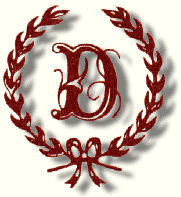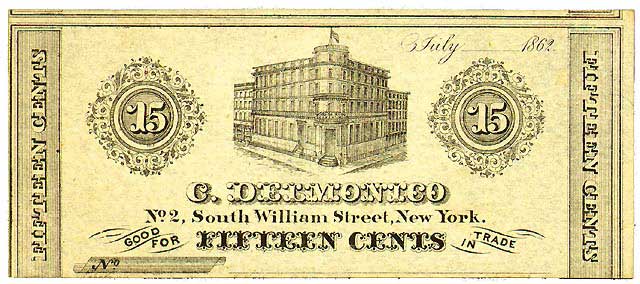History
Delmonico steak: a mystery solved
By
Joe O'Connell,
Food Writer
First posted 3 July 2003 at 1840 GMT
Last updated 30 November 2003 at 1724 GMT
NEW YORK, New York -- The 96-year history of
Delmonico's Restaurant in New York includes many small but interesting
stories. One of them concerns the time that Delmonico's issued its
own money.
Background
On December 13, 1827, Giovanni ("John") and Pietro ("Peter")
Delmonico opened their first cafe, where they sold coffee, wine and
pastries. The business prospered, and they had the immense good
fortune to bring their nephew, Lorenzo, into the business. Under
Lorenzo's constant attention to excellence in every detail, Delmonico's
Restaurant became synonymous with the highest standards of food and
service.
By 1860, there were two Delmonico's Restaurants in New York:
the downtown location, on South William Street (called the "Citadel"),
and the uptown location, at the corner of Chambers Street and Broadway.
In 1836, the Bank of the United States ceased to exist, and this
began the 30-year period called the Free Banking Era. During this
period, there was no central bank. Instead, there was a hodgepodge
of state laws without federal regulation, and almost any business could
issue its own money. Not just states and private banks, but
railroads, stores, and even individuals issued their own currency.
The problem was that a dollar issued by the City of Atlanta was worth
far less than a dollar issued by the City of New York. By 1860,
more than 30,000 different notes were in circulation, and perhaps a
third of them were counterfeit, fraudulent or worthless. Shoppers
had to fill their wallets with notes of different sizes, shapes, and
designs.
In 1863, the Free Banking Era ended when the United States enacted
the National Bank Act. Fed.
Delmonico's Script
During the Civil War, Delmonico's Restaurant issued its own private
issue currency. One of its notes is shown below.
Fed. The note is dated July
1862. It shows the restaurant at No. 2 South William Street
(called the "Citadel"), but the note does not bear the name of the
restaurant. Instead, the note bears the name "C. Delmonico."

C. Delmonico was Charles Constant Delmonico ("Old Charlie"). He
was Lorenzo's brother and the manger of the Citadel.
Conclusion
During the Civil War, Delmonico's Restaurant issued its own currency.
The currency was used then in the same way that currency is used today:
shoppers could use the Delmonico script to pay for their purchases, not
just at Delmonico's Restaurant, but at any business in New York and,
indeed the United States. Such was the power of the Delmonico name
and reputation.
Related information
|